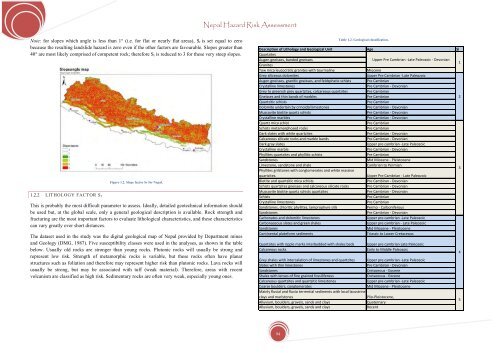Nepal Hazard Risk Assessment - Asia-Pacific Gateway for Disaster ...
Nepal Hazard Risk Assessment - Asia-Pacific Gateway for Disaster ...
Nepal Hazard Risk Assessment - Asia-Pacific Gateway for Disaster ...
You also want an ePaper? Increase the reach of your titles
YUMPU automatically turns print PDFs into web optimized ePapers that Google loves.
<strong>Nepal</strong> <strong>Hazard</strong> <strong>Risk</strong> <strong>Assessment</strong><br />
Note: <strong>for</strong> slopes which angle is less than 1° (i.e. <strong>for</strong> flat or nearly flat areas), S r is set equal to zero<br />
because the resulting landslide hazard is zero even if the other factors are favourable. Slopes greater than<br />
40° are most likely comprised of competent rock; there<strong>for</strong>e S r is reduced to 3 <strong>for</strong> these very steep slopes.<br />
1.2.2 LITHOLOGY FACTOR S I<br />
Figure 1.2. Slope factor Sr <strong>for</strong> <strong>Nepal</strong>.<br />
This is probably the most difficult parameter to assess. Ideally, detailed geotechnical in<strong>for</strong>mation should<br />
be used but, at the global scale, only a general geological description is available. Rock strength and<br />
fracturing are the most important factors to evaluate lithological characteristics, and these characteristics<br />
can vary greatly over short distances.<br />
The dataset used in the study was the digital geological map of <strong>Nepal</strong> provided by Department mines<br />
and Geology (DMG, 1987). Five susceptibility classes were used in the analyses, as shown in the table<br />
below. Usually old rocks are stronger than young rocks. Plutonic rocks will usually be strong and<br />
represent low risk. Strength of metamorphic rocks is variable, but these rocks often have planar<br />
structures such as foliation and there<strong>for</strong>e may represent higher risk than plutonic rocks. Lava rocks will<br />
usually be strong, but may be associated with tuff (weak material). There<strong>for</strong>e, areas with recent<br />
volcanism are classified as high risk. Sedimentary rocks are often very weak, especially young ones.<br />
Table 1.2. Geological classification.<br />
Description of Lithology and Geological Unit Age Si<br />
Quartzites<br />
Augen gneisses, banded gneisses<br />
Upper Pre Cambrian ‐Late Paleozoic ‐ Devonian<br />
Granites<br />
1<br />
Tow mica leucocratic granites with tourmaline<br />
Miocene<br />
Grey siliceous dolomites<br />
Upper Pre Cambrian ‐Late Paleozoic<br />
Augen gneisses, granitic gneisses, and feldsphatic schists Pre Cambrian<br />
Crystalline limestones<br />
Pre Cambrian ‐ Devonian<br />
Grey to greenish grey quartzites, calcareous quartzites Pre Cambrian<br />
Gneisses and thin bands of marbles<br />
Pre Cambrian<br />
2<br />
Quartzitic schists<br />
Pre Cambrian<br />
Dolomite underlain by crinoidal limestones<br />
Pre Cambrian ‐ Devonian<br />
Muscovite biotite quartz schists<br />
Pre Cambrian ‐ Devonian<br />
Crystalline marbles<br />
Pre Cambrian ‐ Devonian<br />
Quartz mica schist<br />
Pre Cambrian<br />
Schists metamorphosed rocks<br />
Pre Cambrian<br />
Dark slates with white quartzites<br />
Pre Cambrian ‐ Devonian<br />
Calcareous silicate rocks and marble bands<br />
Pre Cambrian ‐ Devonian<br />
Dark gray slates<br />
Upper pre cambrian ‐Late Paleozoic<br />
Crystalline marble<br />
Pre Cambrian ‐ Devonian<br />
Phyllites quartzites and phyllitic schists<br />
Pre Cambrian<br />
Sandstones<br />
Mid Miocene ‐ Pleistocene<br />
Limestone, sandstone and shale<br />
Cambrian to Permian<br />
Phyllites grilstones with conglomerates and white massive<br />
3<br />
quartzites.<br />
Upper Pre Cambrian ‐ Late Paleozoic<br />
Biotite and quartzitic mica schists<br />
Pre Cambiran ‐ Devonian<br />
Schists quartzites gneisses and calcareous silicate rocks Pre Cambrian ‐ Devonian<br />
Muscovite biotite quartz schists quartzites<br />
Pre Cambrian ‐ Devonian<br />
Schists<br />
Pre Cambrian<br />
Crystalline limestones<br />
Pre Cambrian<br />
Sandstones, chloritic phyllites, lamprophyre sills<br />
Permo ‐ Carboniferous<br />
Sandstones<br />
Pre Cambrian ‐ Devonian<br />
Carbonates and dolomitic limestones<br />
Upper pre cambrian ‐Late Paleozoic<br />
Carbonaceous slates and green shales<br />
Upper pre cambrian ‐ Late Paleozoic<br />
Sandstones<br />
Mid Miocene ‐ Pleistocene<br />
Continental plate<strong>for</strong>m sediments<br />
Triassic to Lower Cretaceous<br />
Quartzites with ripple marks interbedded with shales beds<br />
Calcareous rocks<br />
Upper pre cambrian Late Paleozoic<br />
Early to Middle Paleozoic<br />
Grey shales with intercalation of limestones and quartzites Upper pre cambrian ‐Late Paleozoic<br />
Slates with thin limestones<br />
Pre Cambiran ‐ Devonian<br />
Sandstones<br />
Cretaceous ‐ Eocene<br />
Shales with lenses of fine grained fossiliferous<br />
Cretaceous ‐ Eocene<br />
Calcareous quartzites and quartzitic limestones<br />
Upper pre cambrian ‐Late Paleozoic<br />
Coarse boulders, conglomerates<br />
Mid Miocene ‐ Pleistocene<br />
Mainly fluvial and fluvio terrential sediments with local lacustrine<br />
clays and marlstones<br />
Plio‐Pleistocene,<br />
Alluvium, boulders, gravels, sands and clays<br />
Quaternary<br />
Alluvium, boulders, gravels, sands and clays<br />
Recent<br />
4<br />
5<br />
94
















